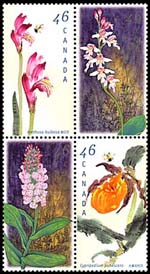Posted Aug 27, 1999
 1999 Orchids of Canada
1999 Orchids of CanadaThe Orchids of Canada stamps appear to be 4 basic designs. However, as we will see, there are actually 11 different stamps available from these 4 designs!
The Orchids were released in two different formats:
![]() booklet pane of 12, issued April 27, 1999
booklet pane of 12, issued April 27, 1999
![]() souvenir sheet of 4, issued August 21, 1999
souvenir sheet of 4, issued August 21, 1999
Why are there 11 different stamps from these 4 basic designs? If you study the full booklet pane and souvenir sheet closely, you will see that those stamps that are adjoining selvedge actually have the design of the stamp extending into the selvedge.
It is true that the selvedge does not constitute a new stamp - if that were the case, there would be hundreds more collectable varieties in Canada during recent years. However, since the design extends into the selvedge, the same design exists in more than one way: the one where the design stops short of the perforation and another (or more) where the design is larger and passes into the perfs!
 Does this constitute additional varieties that should be catalogued by Scott (the major numbering system used in North America) and Unitrade (the specialized catalogue in Canada)? Yes! Scott set a precedent back in 1991 that dictates that there should be 11 major catalogue numbers for the Orchids [ the 1991 USA Christmas stamp showing Santa Claus in a chimney has 2 major catalogue numbers (sc. 2580-81), based on a subtle design difference (one is missing a brick on the chimney) ].
Does this constitute additional varieties that should be catalogued by Scott (the major numbering system used in North America) and Unitrade (the specialized catalogue in Canada)? Yes! Scott set a precedent back in 1991 that dictates that there should be 11 major catalogue numbers for the Orchids [ the 1991 USA Christmas stamp showing Santa Claus in a chimney has 2 major catalogue numbers (sc. 2580-81), based on a subtle design difference (one is missing a brick on the chimney) ].
Each of the 4 designs is repeated 4 different times throughout the booklet pane and souvenir sheet as illustrated in the black & white images to the right. The booklet pane contains 3 examples of each design, in a somewhat random placement, while the souvenir sheet contains 1 of each design. I have numbered each position for specific referencing in the tables that follow.
The 4 basic designs feature the following orchids:
![]() dragon's mouth, Arethusa bulbosa (sc. 1787)
dragon's mouth, Arethusa bulbosa (sc. 1787)
![]() small round-leaved orchid, Amerorchis rotundifolia (sc. 1788)
small round-leaved orchid, Amerorchis rotundifolia (sc. 1788)
![]() small purple fringed orchid, Platanthera psycodes (sc. 1789)
small purple fringed orchid, Platanthera psycodes (sc. 1789)
![]() greater yellow lady's-slipper, Cypripedium pubescens (sc. 1790)
greater yellow lady's-slipper, Cypripedium pubescens (sc. 1790)
Here are the 4 basic stamps and the various major design varieties that exist (an italicized position indicates the stamp is from the souvenir sheet):

![]() Arethusa bulbosa (sc. 1787)
Arethusa bulbosa (sc. 1787)
| Position | Variation | ||
| 1, 9, 13 | design stops short of perforations on all 4 sides | ||
| 11 | stems extend through bottom perfs | ||

![]() Amerorchis rotundifolia (sc. 1788)
Amerorchis rotundifolia (sc. 1788)
| Position | Variation | ||
| 2, 6, 14 | design stops short of perforations on all 4 sides | ||
| 10 | lower leaf and stem extend through bottom perfs | ||
![]() Platanthera psycodes (sc. 1789)
Platanthera psycodes (sc. 1789)

| Position | Variation | ||
| 4 | left leaves extend through left perfs | ||
| 8 | design stops short of perforations on all 4 sides | ||
| 12 | stem extends through bottom perfs | ||
| 15 | left leaves extend extend through left perfs and stem extends through bottom perfs | ||
![]() Cypripedium pubescens (sc. 1790)
Cypripedium pubescens (sc. 1790)

| Position | Variation | ||
| 3, 16 | right leaves extend through right perfs | ||
| 5 | design stops short of perforations on all 4 sides (background at lower left is also light gray) | ||
| 7 | left leaves extend through left perfs (background is also white without the shading) | ||
A note about selvedge.
Philatelists should not remove the selvedge from a stamp, particularly if the stamp contains some form of text and/or illustration. With that said, most of the general public will remove the selvedge before applying the stamp(s) to the envelope.
The colour illustrations above show the single stamps without any selvedge (if applicable). This was done on purpose to show the 11 different varieties. However, I am not condoning the removal of the selvedge for placement in your album!
Many collectors like to reassemble booklet panes from their used stamps. If you are lucky enough to have the orchid stamps with selvedge attached, it is possible to very easily identify each of the 16 different positions noted above! However, since the catalogues do not recognize selvedge when assigning catalogue numbers, and as we have seen above, we are left with 11 design-different orchids.
Scarcity
Recent Canadian commemoratives are relatively hard to find in used condition. The more popular commemoratives that one seems to see more often are those from booklets, particularly the recent self-adhesive horses. Orchid stamps from the booklet pane will likely be found with the selvedge attached (where applicable) since the selvedge is quite small.
I doubt that many Orchids from the souvenir sheet will be used for postage (except those that are philatelically created). Good luck finding any of these with the selvedge attached. Notice that the Platanthera psycodes stamp from the souvenir sheet is different from any of the 3 found in the booklet pane.
Happy hunting...
© 1995-2017, 2018 Robin Harris
Adminware is a trademark of Adminware Corporation.
